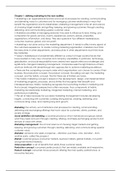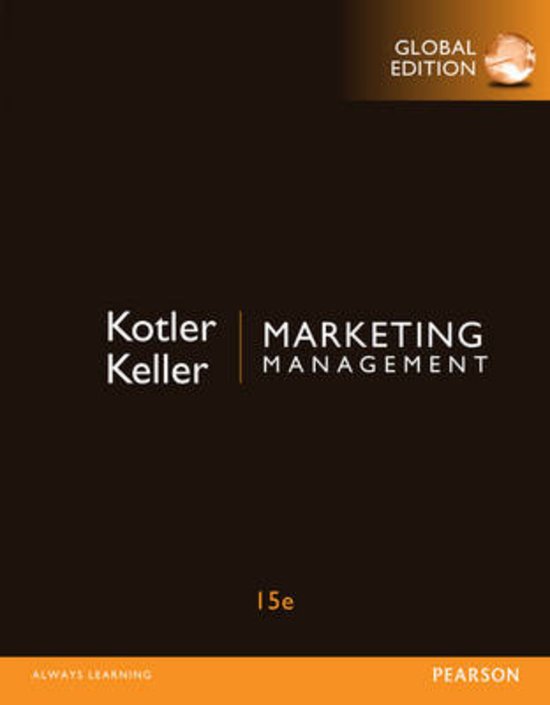Marketing
Chapter 1: defining marketing for the new realities:
• Marketing is an organizational function and a set of processes for creating, communicating,
and delivering value to customers and for managing customer relationships in ways that
benefit the organization and its stakeholders. Marketing management is the art and science
of choosing target markets and getting, keeping, and growing customers through creating,
delivering, and communicating superior customer value.
• Marketers are skilled at managing demand: they seek to influence its level, timing, and
composition for goods, services, events, experiences, persons, places, properties,
organizations, information, and ideas. They also operate in four different marketplaces:
consumer, business, global, and non-profit.
• Marketing is not done only by the marketing department. It needs to affect every aspect of
the customers experience. To create a strong marketing organization, marketers must think
like executives in other departments, and executives in other departments must think more
like marketers.
• Today’s marketplace is fundamentally different as a result of major societal forces that
have resulted in many new consumer and company capabilities. In particular, technology,
globalization, and social responsibility have created new opportunities and challenges and
significantly changed marketing management. Companies seek the right balance of tried-
and-true methods with breakthrough new approaches to achieve marketing excellence.
• There are five competing concepts under which organizations can choose to conduct their
business: the production concept, the product concept, the selling concept, the marketing
concept, and the holistic concept. The first three are of limited use today.
• The holistic marketing concept is based on the development, design, and implementation
of marketing programs, processes, and activities that recognize their breadth and
interdependencies. Holistic marketing recognizes that everything matters in marketing and
that a broad, integrated perspective is often necessary. Four components of holistic
marketing are relationship marketing, integrated marketing, internal marketing, and
performance marketing.
• The set of tasks necessary for successful marketing management includes developing
insights, connecting with customers, building strong brands, creating, delivering, and
communicating value, and creating long-term growth.
Marketing: the activity, set of institutions and processes for creating, communicating,
delivering and exchanging offerings that have value for customers, clients, partners, and
society at large.
Social (definition of) marketing: a societal process by which individuals and groups obtain
what they need and want through creating, offering, and freely exchanging products and
services of value with others.
Marketing management: the art and science of choosing target markets and getting,
keeping, and growing customers through creating, delivering, and communicating superior
customer value.
Marketer: someone who seeks a response – attention, purchase, vote, donation – from
another party, called the prospect.
Market: customer groups (consumer markets, business markets, global markets, non-profit
and governmental markets).
Value proposition: a set of benefits that satisfy those customer needs.
Production concept: consumers prefer products that are widely available and inexpensive.
Product concept: consumers favour products offering the most quality, performance, or
innovative features.
, Marketing
Selling concept: consumers and business won’t buy enough of the organizations product, if
left alone.
Marketing concept: the job is to find the right product for your customer.
Holistic marketing: based on development, design, and implementation of marketing
programs, processes, and activities that recognize their breadth and interdependencies.
Relationship marketing: aims to build mutually satisfying long-term relationships with key
constituents in order to earn and retain their business.
Marketing network: the company and its supporting stakeholders with whom it has built
mutually profitable business relationships.
Internal marketing: the task of hiring, training, and motivating able employees.
Performance marketing: requires understanding the financial and nonfinancial returns to
business and society from marketing activities and programs.
Why is marketing important (page 25)?
A company needs demand for their products and services to make a profit. With marketing
you create demand. Successful marketing allows firms to more fully engage in socially
responsible activities.
What is the scope of marketing (page 27)?
Marketing is about identifying and meeting human and social needs. Goods, services,
events, experiences, persons, places properties, organizations, information and ideas
are marketed. Marketers markets, they seek a response from another party.
What are some core marketing concepts (page 31)?
- Needs, wants, and demands;
- Target markets, positioning, and segmentation;
- Marketing channels communication, distribution and service channels;
- Paid, owned, and earned media paid media: marketers show ad or brand for a fee.
Owned media: communication channels marketers own. Earned media: someone
communicates voluntarily about the brand.
- Impressions and engagement: Impressions occur when consumers view a communication
and are useful for tracking the scope or breadth of a communication’s reach. Engagement is
the extent of a customer’s involvement with a communication.
- Value and satisfaction: the buyer chooses the offering he or she perceives to deliver the
most value. Satisfaction reflects a person’s judgement of a product performance.
- Supply chain: a channel stretching from raw materials to finished product.
- Competition: all the actual and potential rival offerings and substitutes.
- Marketing environment: the task environment (includes the actors engaged in producing,
distributing, and promoting) and the broad environment (demographic, economic, social-
cultural, natural, technological, political-legal).
What forces are defining the new marketing realities (page 35)?
Technology, globalization and social responsibility.
What new capabilities have these forces given consumers and companies (page
38)?
They are bringing the customers and companies new capabilities. The marketplace is being
transformed by changes in channel structure and heightened competition.
What does a holistic marketing philosophy include (page 42)?
See definition above recognizes and reconciles the scope and complexity.
What tasks are necessary for successful marketing management (page 49)?
, Marketing
Developing marketing strategies and plans, capturing marketing insights, connecting with
customers, building strong brands, creating value, delivering value, and conducting
marketing responsibly for long-term success.
Chapter 2: developing marketing strategies and plans
• The value delivery process includes choosing (or identifying), providing (or delivering), and
communicating superior value. The value chain is a tool for identifying key activities that
create value and costs in a specific business.
• Strong companies develop superior capabilities in managing core business processes such
as new-product realization, inventory management, and customer acquisition and retention.
In today’s marketing environment, managing these core processes effectively means
creating a marketing network in which the company works closely with all parties in the
production and distribution chain, from suppliers of raw materials to retail distributors.
Companies no longer compete – marketing networks do.
• Market-oriented strategic planning is the managerial process of developing and
maintaining a viable fit between the organization’s objectives, skills, and resources and its
changing market opportunities. The aim of strategic planning is to shape the company’s
businesses and products so they yield target profits and growth. Strategic planning takes
place at four levels: corporate, division, business unit, and product.
• The corporate strategy establishes the framework within which the divisions and business
units prepare their strategic plans. Setting a corporate strategy means defining the corporate
mission, establishing strategic business units (SBUs), assigning resources to each, and assessing
growth opportunities.
• Marketers should define a business or business unit as a customer-satisfying process. Taking
this view can reveal additional growth opportunities.
• Strategic planning for individual businesses includes defining the business mission, analyzing
external opportunities and threats, analyzing internal strengths and weaknesses, formulating
goals, formulating strategy, formulating supporting programs, implementing the programs,
and gathering feedback and exercising control.
• Each product level within a business unit must develop a marketing plan for achieving its
goals. The marketing plan is one of the most important outputs of the marketing process.
Value chain: a tool for identifying ways to create more customer value.
Value delivery network: a company’s supply chain and how it partners with specific suppliers
and distributors to make products and bring them to markets.
Supply chain: from raw materials to components to finished products.
Core competency: attribute that (1) is a source of competitive advantage in that it makes a
significant contribution to perceived customer benefits, (2) has applications in a wide variety
of markets, and (3) is difficult for competitors to imitate.
Marketing plan: written document that summarizes what the marketer has learned about the
marketplace, indicates how the firm plans to reach its marketing objectives, and helps direct
and coordinate the marketing effort.
Strategic marketing plan: laying out the target markets and the value proposition that will be
offered, based on analysis of the best market opportunities.
Tactical marketing plan: marketing tactics, including product features, promotion,
merchandising, pricing, sales channels, and service.
Mission statement: a statement that an organization develops to share with managers,
employees, and customers.
, Marketing
Strategic business units (SBUs): a single business or collection or related businesses that can be
planned separately from the rest of the company, with its own set of competitors and a
manager who is responsible for strategic planning and profit performance.
Organization: a company’s structures, policies, and corporate culture.
Corporate culture: the shared experiences, stories, beliefs, and norms that characterize an
organization.
Marketing opportunity: an area of buyer need and interest in which there is a high probability
that a company can profitably satisfy that need.
Market opportunity analysis: system used to determine the attractiveness and probability of
success.
Environmental threat: a challenge posed by an unfavourable trend or development that
would lead to lower sales or profit.
Goal formulation: the process of developing specific goals for the planning period.
Strategy: a company’s game plan for achieving its goals.
Strategic group: firms pursuing the same strategy directed to the same market.
Partner relationship management (PRM): activities the firm undertakes to build mutually
satisfying long-term relations with key partners.
Risk analysis: a method by which possible rates of returns and their probabilities are
calculated by obtaining estimates for uncertain variables affecting profitability.
How does marketing affect customer value (page 57)?
__________________________________________________________________________________________
__________________________________________________________________________________________
__________________________________________________________________________________________
__________________________________________________________________________________________
__________________________________________________________________________________________
How is strategic planning carried out at the corporate and divisional levels (page 60)?
__________________________________________________________________________________________
__________________________________________________________________________________________
__________________________________________________________________________________________
__________________________________________________________________________________________
__________________________________________________________________________________________
How is strategic planning carried out at the business unit level (page 70)?
__________________________________________________________________________________________
__________________________________________________________________________________________
__________________________________________________________________________________________
__________________________________________________________________________________________
__________________________________________________________________________________________
What does a marketing plan include (page 77)?
__________________________________________________________________________________________
__________________________________________________________________________________________
__________________________________________________________________________________________
__________________________________________________________________________________________
__________________________________________________________________________________________
__________________________________________________________________________________________





